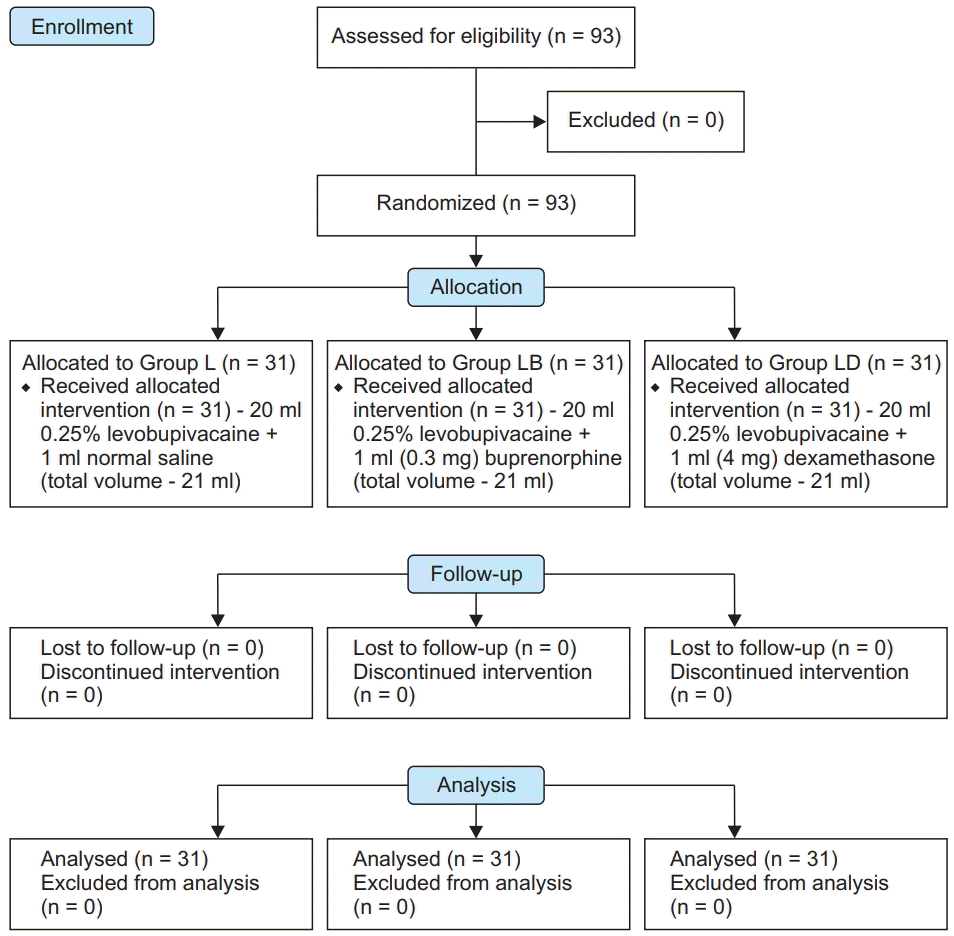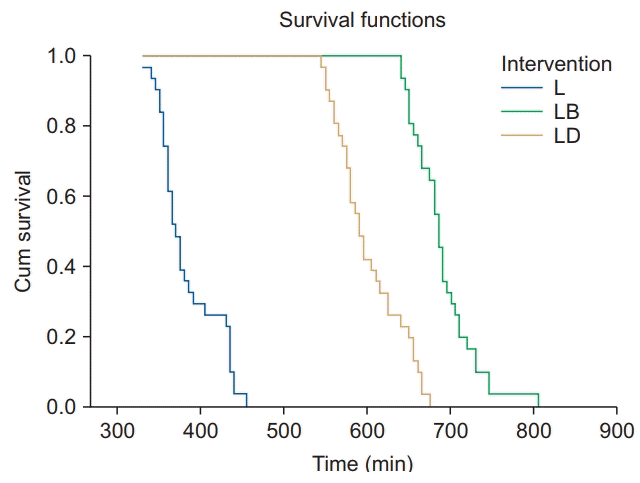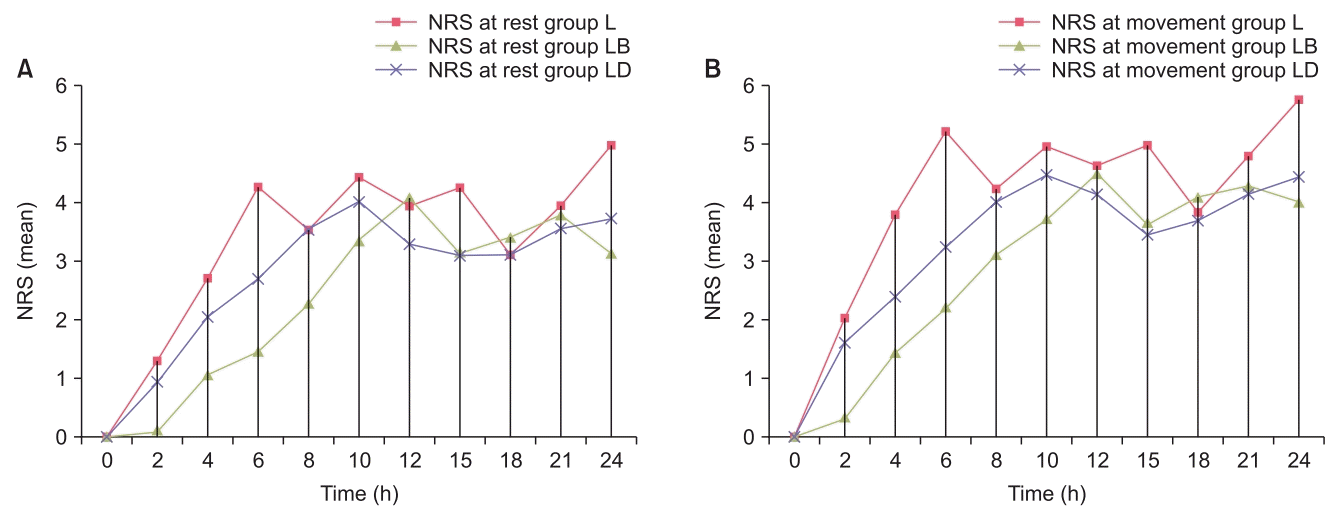1. Ammar AS, Mahmoud KM. Effect of adding dexamethasone to bupivacaine on transversus abdominis plane block for abdominal hysterectomy: A prospective randomized controlled trial. Saudi J Anaesth. 2012; 6:229–33.

2. Abdallah FW, Halpern SH, Margarido CB. Transversus abdominis plane block for postoperative analgesia after Caesarean delivery performed under spinal anaesthesia? A systematic review and meta-analysis. Br J Anaesth. 2012; 109:679–87.

3. Bajwa SJ, Kaur J. Clinical profile of levobupivacaine in regional anesthesia: A systematic review. J Anaesthesiol Clin Pharmacol. 2013; 29:530–9.

4. Saraghi M, Hersh EV. Three newly approved analgesics: an update. Anesth Prog. 2013; 60:178–87.

5. Bonnet F, Berger J, Aveline C. Transversus abdominis plane block: what is its role in postoperative analgesia? Br J Anaesth. 2009; 103:468–70.

6. Al-Touny AA, Al-Kassaby AM, Omera MA, Atef HM. The postoperative analgesic efficacy of transversus abdominis plane (TAP) block using bupivacine verus bupivacine-morphine after inguinal herniorrhaphy. Med J Cairo Univ. 2013; 81:1–7.
7. Candido KD, Winnie AP, Ghaleb AH, Fattouh MW, Franco CD. Buprenorphine added to the local anesthetic for axillary brachial plexus block prolongs postoperative analgesia. Reg Anesth Pain Med. 2002; 27:162–7.

8. Candido KD, Hennes J, Gonzalez S, Mikat-Stevens M, Pinzur M, Vasic V, et al. Buprenorphine enhances and prolongs the postoperative analgesic effect of bupivacaine in patients receiving infragluteal sciatic nerve block. Anesthesiology. 2010; 113:1419–26.

9. Venkatraman R, Abhinaya RJ, Sakthivel A, Sivarajan G. Efficacy of ultrasound-guided transversus abdominis plane block for postoperative analgesia in patients undergoing inguinal hernia repair. Local Reg Anesth. 2016; 9:7–12.

10. Akkaya A, Yildiz I, Tekelioglu UY, Demirhan A, Bayir H, Ozlu T, et al. Dexamethasone added to levobupivacaine in ultrasound-guided tranversus abdominis plain block increased the duration of postoperative analgesia after caesarean section: a randomized, double blind, controlled trial. Eur Rev Med Pharmacol Sci. 2014; 18:717–22.
11. Nirmala J, Kumar A, Devraj R, Vidyasagar S, Ramachandraiah G, Murthy PV. Role of buprenorphine in prolonging the duration of post-operative analgesia in percutaneous nephrolithotomy: Comparison between bupivacaine versus bupivacaine and buprenorphine combination. Indian J Urol. 2015; 31:132–5.

12. Yu N, Long X, Lujan-Hernandez JR, Succar J, Xin X, Wang X. Transversus abdominis-plane block versus local anesthetic wound infiltration in lower abdominal surgery: a systematic review and meta-analysis of randomized controlled trials. BMC Anesthesiol. 2014; 14:121.

13. Johns N, O'Neill S, Ventham NT, Barron F, Brady RR, Daniel T. Clinical effectiveness of transversus abdominis plane (TAP) block in abdominal surgery: a systematic review and meta-analysis. Colorectal Dis. 2012; 14:e635–42.

14. Weiss E, Jolly C, Dumoulin JL, Meftah RB, Blanié P, Laloë PA, et al. Convulsions in 2 patients after bilateral ultrasound-guided transversus abdominis plane blocks for cesarean analgesia. Reg Anesth Pain Med. 2014; 39:248–51.

15. Siddiqui MR, Sajid MS, Uncles DR, Cheek L, Baig MK. A meta-analysis on the clinical effectiveness of transversus abdominis plane block. J Clin Anesth. 2011; 23:7–14.

16. Picard PR, Tramèr MR, McQuay HJ, Moore RA. Analgesic efficacy of peripheral opioids (all except intra-articular): a qualitative systematic review of randomised controlled trials. Pain. 1997; 72:309–18.

17. Downing JW, Leary WP, White ES. Buprenorphine: a new potent long-acting synthetic analgesic. Comparison with morphine. Br J Anaesth. 1977; 49:251–5.

18. Bazin JE, Massoni C, Bruelle P, Fenies V, Groslier D, Schoeffler P. The addition of opioids to local anaesthetics in brachial plexus block: the comparative effects of morphine, buprenorphine and sufentanil. Anaesthesia. 1997; 52:858–62.

19. Kosel J, Bobik P, Siemiątkowski A. Buprenorphine added to bupivacaine prolongs femoral nerve block duration and improves analgesia in patients undergoing primary total knee arthroplasty-a randomised prospective double-blind study. J Arthroplasty. 2015; 30:320–4.

20. El Sharnouby NM, El Gendy HA. Ultrasound-guided single injection transversus abdominis plane block of isobaric bupivacaine with or without dexamethasone for bariatric patients undergoing laparoscopic vertical banded gastroplasty: a comparative study of different doses. Ain-Shams J Anaesthesiol. 2015; 8:194–9.

21. Leffler A, Frank G, Kistner K, Niedermirtl F, Koppert W, Reeh PW, et al. Local anesthetic-like inhibition of voltage-gated Na(+) channels by the partial μ-opioid receptor agonist buprenorphine. Anesthesiology. 2012; 116:1335–46.
22. Stein C. Peripheral mechanisms of opioid analgesia. Anesth Analg. 1993; 76:182–91.

23. Koppert W, Ihmsen H, Körber N, Wehrfritz A, Sittl R, Schmelz M, et al. Different profiles of buprenorphine-induced analgesia and antihyperalgesia in a human pain model. Pain. 2005; 118:15–22.

24. Behr A, Freo U, Ori C, Westermann B, Alemanno F. Buprenorphine added to levobupivacaine enhances postoperative analgesia of middle interscalene brachial plexus block. J Anesth. 2012; 26:746–51.

25. Jadon A, Panigrahi MR, Parida SS, Chakraborty S, Agrawal PS, Panda A. Buprenorphine improves the efficacy of bupivacaine in nerve plexus block: A double blind randomized evaluation in subclavian perivascular brachial block. J Anaesthesiol Clin Pharmacol. 2009; 25:207–10.
26. Yildiz I, Bayir H. Effect of dexamethasone added to levobupivacaine used for TAP block. Hippokratia. 2015; 19:285.
27. Johansson A, Hao J, Sjölund B. Local corticosteroid application blocks transmission in normal nociceptive C-fibres. Acta Anaesthesiol Scand. 1990; 34:335–8.

28. Chu CC, Hsing CH, Shieh JP, Chien CC, Ho CM, Wang JJ. The cellular mechanisms of the antiemetic action of dexamethasone and related glucocorticoids against vomiting. Eur J Pharmacol. 2014; 722:48–54.





 PDF
PDF Citation
Citation Print
Print






 XML Download
XML Download